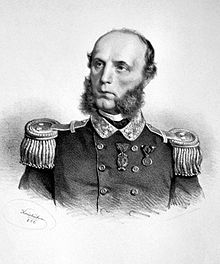Wilhelm von Tegetthoff
| Wilhelm von Tegetthoff | |
|---|---|

Wilhelm von Tegetthoff, litography by Joseph Kriehuber, 1866
|
|
| Born |
23 December 1827 Marburg, Styria, Austrian Empire (now Maribor in Slovenia) |
| Died | 7 April 1871 (aged 43) Vienna, Austria-Hungary (modern Austria) |
| Allegiance |
|
| Service/branch |
|
| Years of service | 1840–1871 |
| Rank | Viceadmiral |
| Battles/wars | |
Wilhelm von Tegetthoff (23 December 1827 – 7 April 1871) was an Austrian admiral. He commanded the fleet of the North Sea during the Second Schleswig War of 1864, and the Austro-Prussian War of 1866. He is often considered one of the best naval officers of the 19th century, due to his tactical inventiveness, sense of command, and inspirational leadership.
Tegetthoff was born in Marburg, Styria in Austrian Empire (now Maribor in Slovenia), on 23 December 1827 the son of Karl von Tegetthoff, an Oberstleutnant in the Austrian Army. On his mother's side he was related to Johann Kaspar Freiherr von Seiller, Mayor of Vienna from 1851 to 1861. Entering the Marinecollegium (naval academy) in Venice in 1840, Tegetthoff became a Seekadett on 23 July 1845 and witnessed the Venetian uprising in 1848/49. He received a commission upon his graduation on 16 April 1849 and took part in the blockade of Venice from May to August 1849. Tegetthoff was promoted to Fregattenleutnant on 16 June 1851 and Linienschiffsleutnant on 16 November 1852.
Tegetthoff received his first command, the naval schooner Elisabeth, in 1854. This was at the time of the Austrian Navy's intensive conversion to steam power, of which he was an earnest advocate. In 1855 he was appointed commander of the paddle steamer Taurus, patrolling the Sulina mouth of the Danube during the Crimean War. This service brought him to the favorable notice of Archduke Ferdinand Maximilian of Austria, the Oberkommandant der Marine (High Commander of the Navy), with whom he had been acquainted since 1850. Promoted to Korvettenkapitän in 1857, Tegetthoff served on a semi-official scientific expedition to the Red Sea. Having shown exceptional diplomatic and organizational ability, in December 1857 he was appointed a staff officer. He was named commander in 1858 of the new screw corvette Erzherzog Friedrich on the coast of Morocco, then in a confused state of disorder.
...
Wikipedia
